August 16th, 2017
How to Take On the Tech Take-over
Fifty years ago, the average person read the newspaper in the morning, thumbed through a magazine over lunch and watched one of three TV channels after work.
Today, things have changed. It’s not that people don’t watch TV or read magazines. They do. It’s that they don’t do one of those things at a time.
Only one percent of people between the ages of 18 and 34 – who marketers like to call “Millennials” – consistently sit and watch TV while not doing anything else. One percent. That means that nearly everyone in the youngest adult age bracket is a distracted viewer.
They aren’t just watching Dancing with the Stars. They’re sitting on the couch, scanning email on their laptop, reading Twitter on their phone and checking out a sports score on the nearby iPad – all while “watching” a TV show.
 The average American’s access to technology has grown exponentially in the last decade. But one American asset has actually declined: the attention span. Fifteen years ago, the average person’s attention span was about 12 seconds. But since the turn of the millennium, the attention span has been cut by almost 33 percent, to around eight seconds. That’s actually shorter than a goldfish.
The average American’s access to technology has grown exponentially in the last decade. But one American asset has actually declined: the attention span. Fifteen years ago, the average person’s attention span was about 12 seconds. But since the turn of the millennium, the attention span has been cut by almost 33 percent, to around eight seconds. That’s actually shorter than a goldfish.
The sudden decline in attention provides an interesting challenge for marketers. We can reach people on just about any type of platform. But we’re reaching a person in 2017 who pays much less attention than the same type of person may have in 1997.
So what can marketers do to capture people’s diminishing attention? There’s no perfect answer. Thousands of companies spend millions every day trying to solve this puzzle.
Our advice: start with the consumer. Don’t worry about chasing every new fad. Don’t keep yourself up at night wondering how you’re going to do a better job advertising on a tablet or on Twitter or on Connected TV.
Worry about your consumer. Think of what makes them laugh. What makes them cry. What makes them care about your product, your message and your company. Then go do that. If you can connect with your consumer on Snapchat, great! But don’t feel that just because there is a new fad that you have to be there.
The only thing we know for sure about today’s new technology is that it’ll be old news in a few years (or months). Your iPhone will be obsolete and your favorite new app might be out of business. But consumers will still be here and will still be ready to connect with brands that want to connect with them. You just have to get their attention.

August 16th, 2017
Brick-and-Mortar is Here to Stay
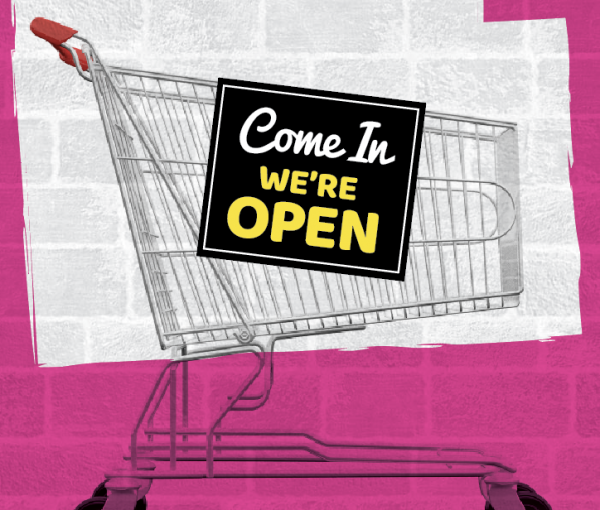 Everyone in the retail world is looking to create the perfect business model. For years, the only choice was brick-and-mortar shopping, and then along came e-commerce. That’s when “retail” became “e-tail.”
Everyone in the retail world is looking to create the perfect business model. For years, the only choice was brick-and-mortar shopping, and then along came e-commerce. That’s when “retail” became “e-tail.”
The most aggressive of the e-tailers (i.e., Amazon) would have us believe that the old-fashioned way of shopping is dying out, but according to a 2017 U.S. Census report, more than 90 percent of purchases are still made through in-store transactions.
What is true is that the advent of e-commerce retail shopping has put a serious dent in the bottom line of traditional brick-and-mortar stores. Regardless of the purported economic upturn, brick-and-mortar stores are still closing at an alarming rate.
To a large extent, those closings can be blamed on traditional retailers. They got greedy. They weren’t happy just to fill the malls; they had to cram them to overflowing, creating claustrophobic crowds of frustrated and angry shoppers. That’s when the e-commerce folks swooped in to save us from this nightmare.
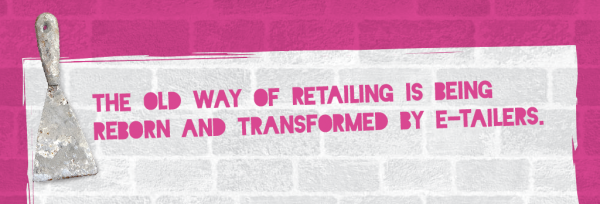
Convenience became the most important piece of the puzzle. Sure, we gave up on seeing products in person, but at least we didn’t have to fight the hordes and stand in those mind-numbing lines. Admittedly, there were challenges to e-commerce, but our time was once again our own – we were in control.
But now, we’re starting to hear about e-commerce companies opening their own stores in an effort to generate a boost in brand awareness and experience – major e-tailers, like Zappos, Birchbox and Warby Parker. Even Amazon, having been cited in RetailDive as “the original disrupter of brick-and-mortar retail,” has dipped its toes into the brick-and-mortar pool – first with book stores and now with an attempt to purchase Whole Foods.
But what we know of brick-and-mortar is evolving. The old way of retailing, which appears to be breathing its last breath, is being reborn and transformed by e-tailers that are breathing new life into the traditional business model.
For example, men’s clothing e-tailers are providing brick-and-mortar places to try on garments that are then shipped to their home from a central warehouse. The Harry’s razor folks opened their first brick-and-mortar shop – a barber shop in NYC. Many companies (i.e., Great Brands, Inc.) are experimenting with short term leases. And pop-up shops are giving e-tailers a chance to jump into brick-and-mortar without making a major, long-term financial commitment.
Industry pundits remind us that starting an e-tail brand now is more difficult than ever. With the proliferation of purchasing choices, there is little chance to stand out from the crowd if your brand is not already firmly planted in the mind of your public. A physical presence and experience is often the boost that’s needed.

Not every e-commerce business can open a brick-and-mortar and just magically see success. Not even the king of all online kings, Amazon.
According to the Codex Group, Amazon accounts for nearly half of all print and electronic book sales in the U.S. So it seemed promising when they planned to open book stores in multiple cities across the U.S. But on May 26, 2017, when Amazon opened an Amazon Books in New York City, the online tycoon was met with some not-so-great reviews. To give you an idea, here’s one by The New York Post writer Raquel Laneri:
“New Amazon Bookstore Looks Like Airport Desperation Pit-Stop,” headline reads.
“Amazon may have finally killed the bookstore once and for all—by opening one.”
In an effort to bring the online shopping experience to a physical store, Amazon seems to have overshot it. Customers were not fans of the fact that the store did not take cash, had no listed prices and made the purchasing process difficult with scattered kiosks. All in all, a swing and a miss.
Moral of the story is the consumer is always going to dictate what will work and what won’t. And just because you’re successful online, doesn’t mean you’re guaranteed success in the world of brick-and-mortar. Get to know your customers and try to understand what they want – not what you think they want.
August 16th, 2017
The Unbundling and Re-bundling of Full-Service Agencies
A few years ago, the full-service agency model really lost its way. In the process, the term became convoluted and pretty much meaningless. It became fashionable for full-service agencies to unbundle and specialize. One big trend was to become a digital-focused shop. Or maybe a social media shop. All the pundits claimed this was the road to success.
At Bozell, we resisted. For two reasons.
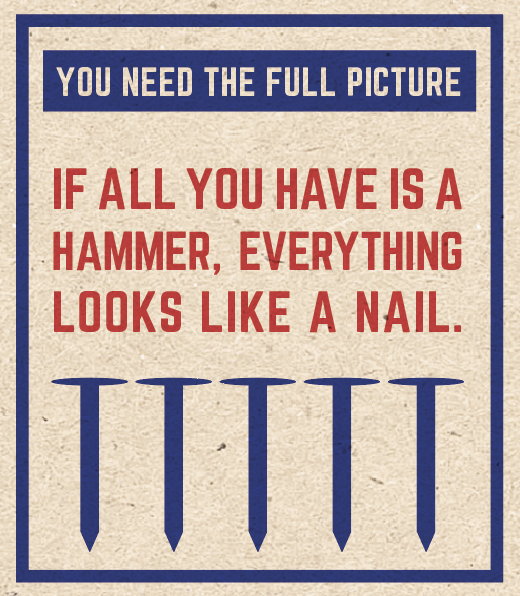 1. It doesn’t give you the full picture.
1. It doesn’t give you the full picture.
The problem with a specialization in one tactic is if all you have is a hammer, everything looks like a nail. And that’s not solving a problem; that’s selling a tactic. To us, these single focuses were just one part of an integrated marketing plan, not a means to an end in themselves. And certainly not something you should build a business around.
2. It makes things more complicated.
Today, there is report after report on the fact that clients are frustrated by the complexity of working with dozens (sometimes even hundreds) of different agencies. Marketers are demanding that agencies simplify processes while continuing to deliver a complex array of marketing services specific to their needs. They want to cull agency lineups, and use fewer agencies (or even a single agency or other party) to lead the multidisciplinary throng.
Enter the great re-bundling.
We’re now seeing things like Ogilvy’s “Refounding” – a restructuring initiative Ogilvy has implemented that focuses on building cross-discipline expertise. Lucky for our clients, we’ve always had cross-functional teams that work together toward an integrated solution among all owned, earned and bought touchpoints. Even when we launched our digital group in 1994, and started integrating social media in 2006 when Facebook first opened its platform to the public, we saw these opportunities not as specialized offerings, but rather as part of an overall marketing toolset. Maybe because, from the very beginning, our founders were problem solvers, not ad guys.
For us, being a full-service agency means:
- We approach the situation with a business mindset and establish key performance indicators (KPIs) up front.
- We take it upon ourselves to learn the clients’ businesses and become students of their industries.
- We always recommend what we believe will achieve the objectives, whether we execute or someone else does.
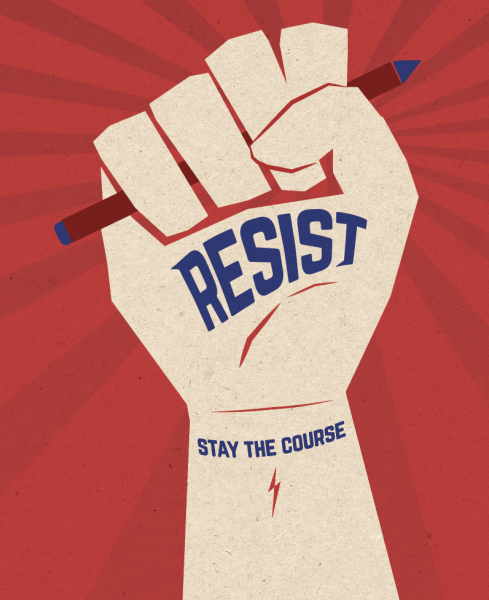 Our teams work together to integrate across all owned, earned and bought channels.
Our teams work together to integrate across all owned, earned and bought channels.- We work with our clients to be able to measure results.
- We monitor and report on all the work we do.
At Bozell, we stayed the course as a full-service consultative agency because we don’t believe the problem was with the full-service approach. We believe the problem in our industry was with the execution. Today, we’re just struggling with the semantics and baggage of the term.
July 27th, 2017
Andy Spaulding
When you can successfully juggle the complaints, concerns and repairs that come with managing dozens of large multi-family residences, keeping residents and owners at bay, there’s a fairly good chance you’ll be able to traffic the workflow of an ad agency – and that’s precisely what Andy does. He’s heard it all, and handled it all. He knows how to get things moving with maximum productivity.
Whether he’s being flown across the country by his favorite rock band or dabbling in cryptozoology one thing’s for sure, Andy is no cold duck, which is probably why his folks ultimately decided against naming him Andre. Whew, that was a close one.
May 17th, 2017
Ahh, technology. Where would we be without it?
Year after year, technology continues to change the way we live. It’s making homes smarter, businesses smarter, our world smarter. And now, as we continue to see more additions to the industry, it’s our duty as marketers to figure out how to incorporate these technologies into our marketing efforts. The difficult question is: how? How do we engage our customers via wearables? How will smart devices change the way our customers buy? How does the Internet of Things (IoT) – the connecting of any device to the internet – create workable data? And how do we sort through all that data?! There’s no easy answer, but with this issue of Thinking, we’ll at least get the marketing wheels turning.

May 17th, 2017
Gadgets and Gizmos
Bozell meets the wonderful world of the IoT and technology.
When it comes to technology, it seems as though new and improved products are unveiled every day. Sure, we read articles about new tech, but if we really want to understand it, we have to give it a try. Today’s new tech could be tomorrow’s great opportunity for clients to reach their customers. Lucky for you, Bozellers are tapped in. Take a look. Here are just a few of our favorites.
Nest Cam Indoor
An indoor security camera that offers 24/7 live streaming and alerts you if it senses motion or noise … AKA: Catching more embarrassing moments than burglars.
“False alarm. Eddie just went on the rug.”
– Kim Mickelsen
Nest Protect
A smoke alarm that communicates the presence of smoke and carbon monoxide in the home by speaking and alerting your phone … AKA: Protects from fires and husbands who can’t cook.
“Takeout, anyone?”
– Kerrey Lubbe
Sharp Business Printers
These smart printers now monitor when your toner is getting low and re-orders automatically for you … AKA: An office manager’s dream.
“The printer’s out of toner.”
– No one at Bozell
Amazon Echo
The voice-activated, in-home device that allows you to search the web, instantly order groceries on Amazon, and so much more … AKA: An eaves-dropper you pay for.
“Alexa, order 10,000 cans of cat food.”
– Every Bozeller to Ryan Weidman’s Amazon Echo
Automatic Pro
Monitor your vehicle with an app that offers trip logging, engine light diagnostics, fill-up logging, crash assistance and live vehicle tracking … AKA: AAA on steroids.
“It’s like my dad is always with me.”
– Bailey Williams
May 17th, 2017
Tech in Unexpected Places
The IoT can help you market to any industry.
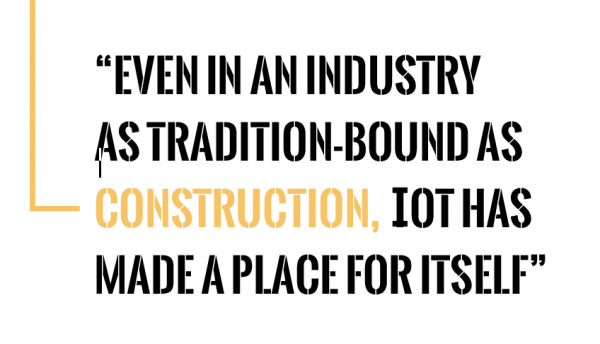 The robots are coming. Scratch that; they’re already here. (Insert Terminator reference here.)
The robots are coming. Scratch that; they’re already here. (Insert Terminator reference here.)
Even in an industry as tradition-bound as construction, IoT has made a place for itself – not as a trendy gadget, but in a true money-saving, quality-enhancing role. GPS-guided earthmoving equipment? Check. Robotic remote-controlled jackhammers and concrete saws? Double-check.
RFID-inventory on the jobsite automatically reorders when supply gets low (and alerts you when it walks off the lot), and remotely monitored pumps tell you ahead of time when they need service, eliminating unexpected delays and costly downtime. Heck, IoT can even eliminate one of my personal pet peeves: time logs. If workers’ equipment is appropriately rigged, whether it’s drills, vehicles or wearable technology, hours can be logged automatically. Limits can be monitored, preventing fatigue and reducing accidents. Big brother isn’t just watching; he’s doing your timesheets for you.
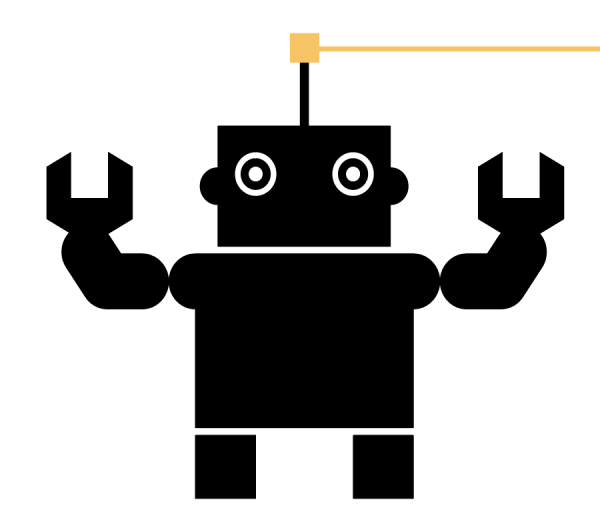 Drones, robots, remote monitoring, embedded technology in the most basic of hand tools – what does all of this have to do with marketing and advertising?
Drones, robots, remote monitoring, embedded technology in the most basic of hand tools – what does all of this have to do with marketing and advertising?
What if when a power tool needed maintenance, a promotional offer for an on-site repair service was also sent? Or when inventory was low, the purchasing agent was sent an ad to consider an alternate brand? Or when a worker was due for a break, the taco truck sent an IM that it was on its way?
A few years ago, I had a client at a major international power tool company. He adamantly stated “Contractors aren’t using mobile. They’re not on social media. You can’t reach them digitally.” That same week, I brought a stack of industry trade magazines to my two neighbors, a mason and a commercial electrician. I asked them which of the publications they read. “None,” was the answer. “I either look stuff up on my phone, or I use the laptop in my truck.”
So what if the technology isn’t quite there today. Do you want to get in early and build your presence? Or do you want to play catch up after your competition has established the leadership position?
Either way, the IoT is coming to even the most conservative of industries.

May 17th, 2017
Always On
How to adapt to the 24/7 marketing cycle that’s dictated by the internet.
525,600 minutes: words from a tune in the musical Rent and the amount of time your brand is expected to be “on” and in front of an audience each year.
Let’s face it. Marketing is now 24/7. But for most marketing professionals, there are typically only 40 hours in a week where we can make an impact. Are you noticing that these numbers aren’t quite adding up?
So where did this constant need for content come from? Two words: TV News. Following the advent of cable television, TV became the leader of the 24-hour news cycle. A relatively new phenomenon (radio was doing the same decades earlier), this brought about the need – and viewers’ desire – for consistent coverage.
Fast forward to the dawn of the internet, which has always been “on” since day one. Every day, we know that someone somewhere is awake and looking at a brand’s website and social channels. Sound a little scary? It might – but we’ve put together some tips and tricks to make sure you and your brand can capitalize on the 24/7 marketing cycle.
Plan Your Work, Work Your Plan 
Taking the time to plan your content, and then staying dedicated to working through that content, and plan, will help you feel relieved of the significant pressure of the 24/7 marketing cycle.
Purposefully slowing down and making a plan – which may seem like the opposite of what you should be doing in the quick-moving cycle – will pay off, and let you and your team create quality content that fosters meaningful relationships between brands and customers.
On top of that, be sure to schedule monthly, bi-monthly or even quarterly meetings with your team to align on trending content ideas and how those can best be achieved with your teams’ capabilities. No one wants to have their employees burn out, and these meetings will ensure their concerns – and achievements – are shared.
 Social Tools & Automation
Social Tools & Automation
Recent reports have shown that Generation Z, the generation just younger than Millennials, actually spends even more time online. This means that marketers won’t be getting a break on creating
content any time soon.
An efficient way to ensure consistent content is published is by familiarizing yourself with each social platform’s native publishing tools, letting you schedule posts for any time of day and enabling your brand to be “on” without actually having to publish it in real time. You can also look to purchase publishing tools like Hootsuite, Sprout Social and Buffer, which can consolidate all of your social accounts in one place.
These tools – both native and purchased – can help you learn more about your audience, including when the majority of your followers are engaged, helping you personalize your content and making sure it isn’t being published when no one is around to hear it.
 Quality vs. Quantity
Quality vs. Quantity
Take the above statement, print it out, and keep it at your desk. Believing in quality over quantity is what will set your brand apart from any other marketer looking to fill news feeds with unneeded clutter.
Publishing three solid, engaging posts a week will do wonders for your brand. But scrambling to share 20-30 a week on one social platform doesn’t make much sense. It’s stressful for you and your team and can make your brand appear to be spamming its followers.
By taking the time to understand your audience, making content plans based on that, and understanding that posting just to post isn’t a brand win, you’ll position your brand on the leading edge of the 24/7 marketing cycle for years to come.
May 17th, 2017
Low-hanging Tech Fruit
How smart technology could be a beneficial part of your marketing plan.
If you’re thinking about adding smart technology to your advertising media roster, but you aren’t sure where to begin, let’s start with the technologies that are already widely talked about and used by consumers – virtual reality headsets and smartwatches.
Virtual Reality Headsets
 If you think virtual reality is only for gamers, you are mistaken. Applications for experiential marketing opportunities can provide unique and exciting ways for you to engage with your customers. Large brands such as Ford and the New York Times are taking advantage of virtual reality. AT&T tapped into this with their “It Can Wait” campaign to address smartphone usage while driving. Bozell used that same virtual reality tool for further awareness at the local level with Knowles Law Firm. A distracted driving message was shared with nearly 8,000 people locally, enabling personalized outreach in the community and attracting thousands of engaged participants.
If you think virtual reality is only for gamers, you are mistaken. Applications for experiential marketing opportunities can provide unique and exciting ways for you to engage with your customers. Large brands such as Ford and the New York Times are taking advantage of virtual reality. AT&T tapped into this with their “It Can Wait” campaign to address smartphone usage while driving. Bozell used that same virtual reality tool for further awareness at the local level with Knowles Law Firm. A distracted driving message was shared with nearly 8,000 people locally, enabling personalized outreach in the community and attracting thousands of engaged participants.
Smartwatches
 Next to fitness trackers, smartwatches are the most purchased wearable. They have a fitness component as the main draw, but because of their ability to collect massive amounts of data and mobile functionalities, the options for tapping into them from a marketing perspective go beyond fitness.
Next to fitness trackers, smartwatches are the most purchased wearable. They have a fitness component as the main draw, but because of their ability to collect massive amounts of data and mobile functionalities, the options for tapping into them from a marketing perspective go beyond fitness.
By design, smartwatches exist to collect quantitative data without consumers doing anything but going about their normal lives. You could have access to data about sleep habits, activity levels, heart rate and more. By studying this data, marketers can take advantage of perfectly timed push notifications such as a discount on running shoes after the consumer completes a long run or a deal on coffee after a poor night of sleep.
Of course, this level of data collection comes with privacy concerns. The best way to alleviate these concerns is by having consumers opt-in. That way, they have control over what types of data they are sharing. Also, emphasize that the data is anonymous and will not be sold to third parties. Privacy isn’t the only pitfall. While smartwatches can be a great way to reach your audience, you only have a bite-size screen on which to convey your message. Keep in mind that it’s not just about running an ad. It’s about adding value through information and utility. Maybe consider making your brand a sponsor of a publisher who shares content that the consumer finds appealing – like daily fitness tips. And you can always try and lead people back to their smartphones if you want them to do more or read more content.
 Though there are plenty of smart technologies out there (and more and more popping up every day), these are two great places to start. But before you invest the marketing dollars, be sure it makes sense for your brand. Ask yourself two questions: “How is this technology being used?” and “How can I make my message relevant to the user?”
Though there are plenty of smart technologies out there (and more and more popping up every day), these are two great places to start. But before you invest the marketing dollars, be sure it makes sense for your brand. Ask yourself two questions: “How is this technology being used?” and “How can I make my message relevant to the user?”
May 17th, 2017
Data Overload
How to make sense of all the data available from your online marketing efforts.
 Impressions, views, time spent, click-through-rate, visits, likes, shares, retweets, open rates, behaviors, … oh my!
Impressions, views, time spent, click-through-rate, visits, likes, shares, retweets, open rates, behaviors, … oh my!
Data is all around us. However, having an arsenal of data alone isn’t going to evolve your business. It’s only going to affect your business if you have a plan to harness it.
Without a plan, data can be misleading. For instance, if your digital TV ads have a below-average click-through rate on the companion banner, you may think there is a problem to resolve. But if the purpose of your video ad was to generate awareness and video completions, the companion banner’s purpose was a branding one and clicks are irrelevant. You don’t want to shift or adapt the plan when your video completion rate is double the standard and those viewers are spending the desired time with your brand. You should stick with the plan.
A goal without a plan is just a wish. Similarly, data without a plan is just the cost of server space.
Here’s how to make data work for you.
Identify core business goals.
You don’t just need a website or to spend more in advertising. You need to identify what you are trying to accomplish – whether it is to grow your business by increasing the frequency of return customers or to grow market share you must prioritize and clarify.
Create measurable objectives.
If you want to grow your business by increasing the frequency of return customers, you may create a measurable objective like “Increase average monthly visits from 2 to 3.”
Build a plan to achieve.
This could include a loyalty program where each third visit in a month gets you a free soda. Increase lunch advertising if your dinner traffic is up but your lunch traffic is down. Don’t forget to set benchmarks for existing efforts.
Generate key performance indicators.
Now that you have a plan, identify what of the hundreds of metrics are indicators that your plan is working. For instance, if it is to increase lunch advertising, you may monitor impressions, click-throughs and online orders.
Report and optimize.
Now that your data is working for you, you know what points to monitor and you can analyze and optimize.


